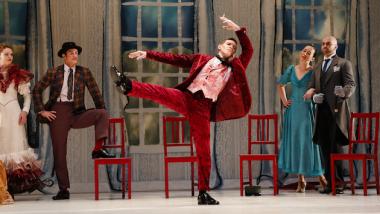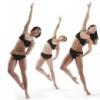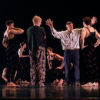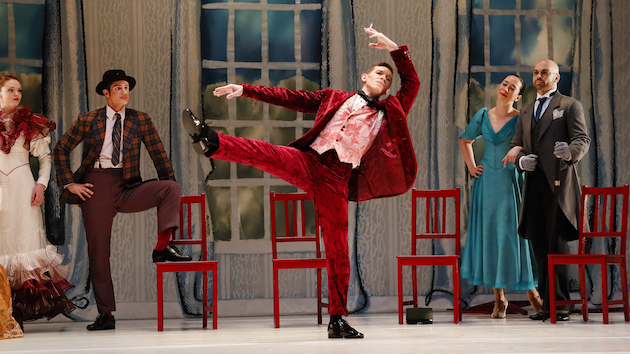
There were hundreds of people hustling down Third Street toward AT&T Park Wednesday night to watch the San Francisco Giants take on the Los Angeles Dodgers. They trotted right past a superb team, opening a brief season in the city with a winning game in a venue only two-thirds full.
Since you’ve come to this website, you know that it was the Paul Taylor Dance Company, playing in three different programs at Yerba Buena Center for the Arts Theater through Sunday. The Giants, bless them, squeaked out a 10th-inning win against the Dodgers; the Taylors, glorious artists all, won the evening despite one new piece, The Open Door, best described as an error. The choreographer finished making it despite being on the injured list. Paul Taylor came to work in the studio in a wheelchair. He shattered his leg last December when he fell through a trap door in his New York City apartment, and thankfully has begun to recover.
Set to Edward Elgar’s Enigma Variations, The Open Door’s setting is a party, with an assortment of individuals, greeted by the Host, dancer Michael Novak, as they enter a lovely blue/green room designed by William Ivey Long, and come to rest on a dozen red chairs.
Taylor’s wit and acuity of observation is unimpeded, and each guest, also costumed by Long, brings something, however weird, to the soiree. It’s a rich array of variations. The soubrette, Madelyn Ho, in a kid’s party dress, is a delightful perpetual motion machine; Michael Trusnovec, as a bro, slouches in shorts and picks a fight with another guest as the Host tries to intervene; a lady in a gold fat suit breaks a chair but then kicks up her sparkly golden dancing heels and twirls in fine form; there’s an effeminate gent in maroon velvet, a soldier, a socialite, a brief waltz for all the guests — you get the drift, even if you’re as at sea as the audience. Novak, luckily for us, gets a solo that displays his musicality and stunning line, reminiscent of Paul Taylor as a dancer in his prime — rare indeed.
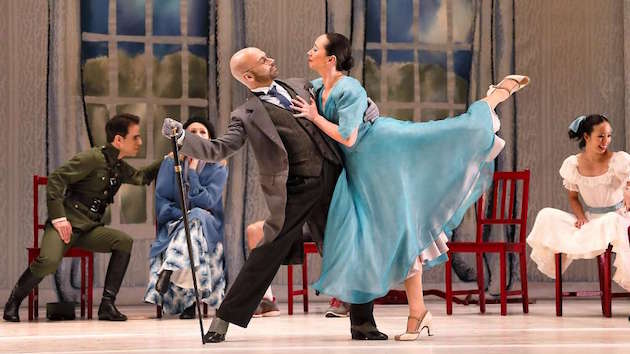
As for the title, the timing of naming it The Open Door might best remain an enigma too. Taylor, 86, has continued to make new works for every single home season, and he is the very last of the modern masters. Hey, even home run kings strike out now and then.
Two polar opposites framed the new work; Taylor’s immortal, lyrical Airs, set to assorted Handel (1978), and his brilliantly frisky, yet mysterious and sublime Syzygy (1987), set to Donald York’s driving, original music (the entire show was on recording).

Airs pays simultaneous tribute to the glories of Handel and the gifts of the seven dancers, highlighted singly (Laura Halzack, radiantly composed) and in duos (Parisa Khobdeh and Robert Kleinendorst; Eran Bugge and Trusnovec), as well as in groups of the men, and the women, and the entire cast. It’s a prismatic view, and the dancers seem to take on a nimbus, caused more by the dance’s balance of tenderness and energy than by Jennifer Tipton’s superb lighting scheme. These dancers glow. The simple motif they share, frequently stretching one arm straight up — heavenward — as they move, seems a gesture of gratitude for the beauty, even the glories, of the work they share.
Syzygy in the program is defined as “the nearly straight line configuration of three or more celestial bodies in a gravitational system.” (Is baseball easier than this?) The dance, for 13, was led by Madelyn Ho, just a year and a half in the company, a diminutive sparkplug who graduated from Harvard with a B.A. in chemical and physical biology and went on to med school. Most of the dancers have amazing resumes, and they tend also to have long careers with Taylor. Rehearsal Director Bettie de Jong, Taylor’s “right arm,” joined the troupe in 1962. But we digress.
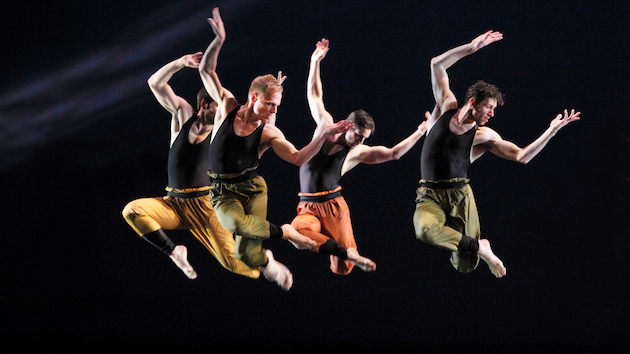
It’s hard to pick out the best thing about Syzygy. It’s partly a serious (or so it appears) attempt to evoke an astral phenomenon in a way that a layperson might understand it, and it’s part a successful attempt to inspire awe, both at the science of the phenomenon and at the way the dancers express it. In both of these aspects, it succeeds mightily. The dancers are garbed by Santo Loquasto in what can only be called play clothes; they’re uniform, but they’re whimsical at the same time. So it’s a serious party, at least partly. Somewhere in the middle of propulsive spins and orbits and leaps and floor turns at top speed there is a sea of tranquility: perhaps a dancer posed in an angular arabesque, turning slowly in time and space, adjacent to another dancer moving in composed, complementary fashion. It’s stunning, for reasons that must be seen to be understood; it’s deeply, glowingly mysterious.
The other mystery is why baseball is more popular than Paul Taylor. If everyone who loved the beauty of America’s game spent a couple of hours this week watching one of America’s greatest dance companies, the score just might change. They don’t have peanuts, but you can take a beer right into the theater.

